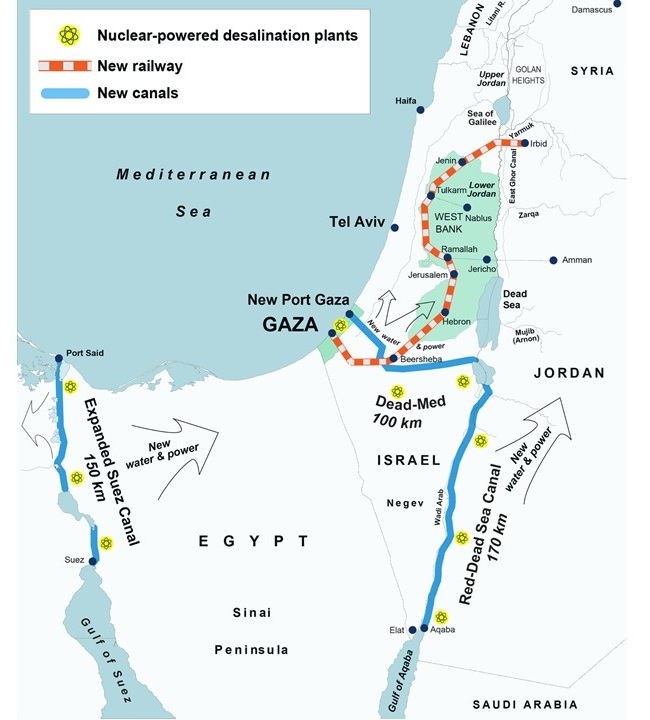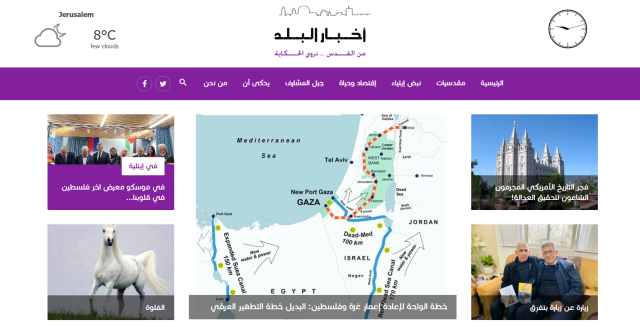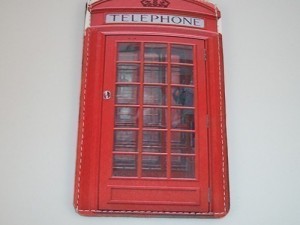Alternativet til den etniske udrensningsplan

Ikke korrekturlæst
Den følgende artikel af Hussein Askary, Schiller Instituttets koordinator for Sydvestasien, blev oprindeligt skrevet på arabisk. Den er bl.a. blevet udgivet her i Jerusalem og af Vestasien- og Afrika-instituttet under det kinesiske akademi for samfundsvidenskab.
De absurde udtalelser fra USA’s præsident Donald Trump, efterfulgt af Benjamin Netanyahus fornærmelser mod nogle vigtige arabiske lande, har givet de arabiske lande mulighed for at fremlægge en alternativ plan, som er realistisk og humanitær og forenelig med folkeretten, for at redde det palæstinensiske folk i Gaza og på Vestbredden, løse det palæstinensiske spørgsmål og etablere fred og udvikling i den vestasiatiske region (fejlagtigt kaldet Mellemøsten). Men det kræver garantier og samarbejde fra internationale magter, først og fremmest den amerikanske regering, men ikke alene. Kina, Rusland, BRIKS-landene, som i år har fået følgeskab af Egypten, De Forenede Arabiske Emirater, Iran og Etiopien, og mange andre lande i det Globale Syd er i dag på vej frem økonomisk, militært og politisk. USA’s udenrigsminister Marco Rubio erkendte for nylig, at unipolaritetens æra er forbi og er blevet erstattet af en æra med multipolaritet. Denne historiske kendsgerning skal udnyttes af de arabiske lande, ikke for at slå Vesten med Østen, men for at bygge broer gennem de arabiske lande mellem dem.
For det første er det bydende nødvendigt at opretholde tostatsløsningen og det palæstinensiske folks ret til at etablere sin egen stat med Østjerusalem som hovedstad på palæstinensisk jord i overensstemmelse med FN’s resolution 242 fra 1967 og det arabiske fredsinitiativ fra 2002. Men hvis denne stat skal være bæredygtig, skal der være en økonomisk politik for genopbygning og udvikling og for at kompensere det palæstinensiske folk og dets yngre generationer for de tragedier og rædsler, de har været udsat for indtil nu.
Portene til humanitær hjælp skal åbnes øjeblikkeligt for at forhindre, at hundredtusinder af palæstinensere i Gaza dør af sult, immundefekt og infektionssygdomme på grund af vandforurening og mangel på sanitære forhold og sundhedspleje. Måske er det, hvad den ekstremistiske israelske regering satser på for at drive det palæstinensiske folk frivilligt ud af Gaza. Vi må huske, hvad der skete i Irak efter Desert Storm i 1991, hvor næsten en million irakere, halvdelen af dem børn, ikke blev dræbt af angloamerikanske bombardementer, men af konsekvenserne af ødelæggelsen af den grundlæggende infrastruktur og den økonomiske blokade på grund af underernæring og spredning af sygdomme.
Oase-planen
Hvad angår den langsigtede plan, er vi glade for den egyptiske regerings udtalelser om, at der er to planer, som vil blive drøftet med de arabiske lande inden det kommende topmøde i slutningen af denne måned. Selv om vi ikke kender detaljerne i disse planer, vil vi gerne fremlægge et sæt ideer inden for det, vi kalder »Oase-planen«, en idé, der blev lanceret af den afdøde amerikanske økonom Lyndon LaRouche i 1970’erne og er baseret på opfattelsen af »fred gennem udvikling«, hvor der ikke er nogen fred uden udvikling og ingen udvikling uden fred, og hvor de to spørgsmål skal foregå sideløbende.
Det var det, der ikke skete i Oslo-aftalen, da de økonomiske beslutninger i bilag III og IV blev negligeret, om end utilstrækkelige, og der kun var fokus på politiske løsninger. Det var det, der fik LaRouche til at forudsige Oslo-aftalens fiasko og advare om den rolle, som det israelske ekstreme højre og dets støtter fra de kristne zionistbevægelser i USA og Storbritannien spillede i at ødelægge ethvert grundlag for fred og myrde og fængsle dets fortalere på begge sider.
Oase-planen skal løse problemerne med vandmangel og ørkendannelse i regionen, manglen på moderne grundlæggende infrastruktur til udvikling og manglen på landbrugs- og industrikapacitet på trods af eksistensen af naturressourcer, geografisk placering, økonomiske og menneskelige ressourcer i regionen, som er ujævnt fordelt i regionen. Planen ser spørgsmålet om genopbygning i Gaza, Palæstina og hele regionen (især Syrien, Libanon, Irak og Yemen) i en større sammenhæng. Det er ikke muligt at finde løsninger på lokale problemer, hvis årsager er globale.
Planen i sin nye form, som denne forfatter og hans kolleger på Schiller Global Institute har udviklet i de sidste to år, begynder i forbindelse med Bælte- og Vej-Initiativet eller den nye Silkevej og sammenkoblingen af Vestasiens infrastruktur og dens udnyttelse som en bro mellem Asien, Europa og Afrika på den ene side og Det Indiske Ocean og Middelhavet på den anden side. Det sker ved at bygge udviklingskorridorer i hele regionen, der hovedsageligt består af transportlinjer som jernbaner, motorveje, vand, elektricitet, olie- og gasrørledninger, og ved at bygge nye landbrugs- og industrizoner og byer på begge sider af disse udviklingskorridorer, som vil strække sig til Palæstina (fra Jordan til Vestbredden, til Gaza, til Middelhavet og derfra til Egypten).
Vand og landbrug:
Planen sigter først og fremmest mod at løse problemerne med vandmangel, underudviklet landbrug og ørkendannelse. Den mængde vand, der er naturligt tilgængelig i regionen, især i Golan, Sydlibanon og på Vestbredden, hvoraf det meste er beslaglagt af Israel, kan man ikke forlade sig på, endda hvis det blev delt retfærdigt og hypotetisk. Der er et behov i hele regionen for at øge mængden af tilgængeligt vand på eksponentiel vis, og det kan kun ske gennem afsaltning af havvand. Der er tre projekter for afsaltning: For det første skal der bygges to kanaler til Det Døde Hav, den ene fra Det Røde Hav og den anden fra Middelhavet. Formålet med disse to kanaler er ikke søtransport, som der går rygter om, og de kan erstattes af rør med stor diameter. Formålet er snarere at udnytte den enorme højdeforskel mellem Det Røde og Det Hvide Hav på den ene side og Det Døde Hav på den anden. Det Døde Hav ligger fire hundrede meter under havets overflade. Den hurtige vandstrøm i de to kanaler, der skråner ned mod Det Døde Hav, kan bruges til at generere energi til afsaltning og andre formål. I fremtiden kan der bygges atomkraftværker med små modulære reaktorer til afsaltning af vand og produktion af elektricitet. Lignende anlæg drevet af enten naturgas eller atomkraft bør i fremtiden også bygges på Middelhavskysten. Landbruget skal udvikles betydeligt i de palæstinensiske områder og i de arabiske nabolande for at opnå fødevaresikkerhed og økonomisk, politisk og sikkerhedsmæssig stabilitet, fordi en stor del af de arabiske landes ressourcer spildes på at importere fødevarer. Der opstår sociale og politiske chok i de arabiske lande, når der er en global krise, som fører til stigende fødevarepriser, som det skete i 2008 og 2009 og efter udbruddet af krigen i Ukraine i 2022. Derfor skal dyrkning og skovrejsning i tørre områder og ørkenområder udvides i hele den arabiske region.
Industrier:
Lyndon LaRouche foreslog på en konference om olie og gas i global politik i Abu Dhabi i 2002, at olieproducerende lande skulle bygge atomkraftværker og bruge deres olie- og gasressourcer til at bygge petrokemiske, kemiske og andre industrier, der øger merværdien af råolie og gas eksponentielt. Et par år senere byggede De Forenede Arabiske Emirater faktisk sit eget fredelige atomprogram og afsluttede opførelsen af fire store atomreaktorer i samarbejde med Sydkorea. Egypten bygger i øjeblikket Dabaa-atomkraftværket i samarbejde med Rusland. Kinas industrielle og teknologiske fremskridt har også gjort det muligt for landet at lokalisere nogle avancerede industrier i arabiske lande som Saudi-Arabien, Oman, De Forenede Arabiske Emirater og Egypten. Alle arabiske lande bør gøre det, ud over at etablere industrier i Gaza og på Vestbredden, og drage fordel af deres geografiske placering, tilgængelighed af råmaterialer og arbejdskraft og nærhed til markeder. Bygningen af en havn i verdensklasse i Gaza, en lufthavn og jernbane- og metrolinjer bør gennemføres.
Finansiering: Vi kan ikke udelukkende forlade os på udenlandsk bistand for at opretholde den økonomiske situation for det palæstinensiske folk og deres fremtidige stat. Oase-planen omfatter etablering af en arabisk eller regional udviklingsbank efter samme model som Asian Infrastructure Investment Bank med en kapital på 100 milliarder dollars. De arabiske lande bør i fællesskab etablere en sådan bank. Dens formål ville ikke kun være at udstede langfristede kreditter med lav rente til finansiering af grundlæggende infrastrukturprojekter i hele regionen, især i Jordan, Palæstina, Libanon og Syrien, men også at give finansiel dækning eller løftestangseffekt til nationale udviklingsbanker, der skal etableres, såsom den palæstinensiske udviklingsbank (som var forudset i Oslo-aftalerne, men som ikke er blevet etableret). Nationale banker ville kunne finansiere lokale projekter inden for boligbyggeri, landbrug og industri. Det ville spare de fattige arabiske lande og det palæstinensiske folk for at være afhængige af udenlandsk bistand, der er forbundet med betingelser og politiske indrømmelser.
Finansieringen kunne komme fra Den Asiatiske Infrastrukturinvesteringsbank (AIIB) og bilaterale »olie-for-konstruktion«- og »olie-for-teknologi«-aftaler, hvor en lille del af regionens olie- og gaseksport (5-10 %) kunne bruges til at finansiere den foreslåede Arabiske Udviklingsbank og til at opnå bilaterale kreditter fra olie- og gasimporterende lande som Kina, Japan, Korea, Indien og europæiske lande og bruge disse kreditter til infrastruktur-, industri- og landbrugsprojekter.
Hvordan kan Gaza genopbygges uden at flytte befolkningen?
Der er mange enkle løsninger, men de kræver god organisering og fælles finansiering. For eksempel har asiatiske lande, herunder Kina, kapacitet til at fremstille små præfabrikerede huse på størrelse med en typisk en-etagers skibscontainer billigt og hurtigt. Den palæstinensiske befolkning i Gaza kan ikke vedvarende bo i telte uden at opleve alle mulige sundhedsmæssige, psykologiske og sociale problemer. Der kunne bygges fælles sanitetsfaciliteter omkring klynger af sådanne boliger langs Gazas kystlinje, som forsynes med vand, elektricitet og spildevandsrensning via flydende kraftværker og afsaltningsanlæg, som findes mange steder i verden eller kan bygges hurtigt.
Oase-planen er en plan, der, selv om den er regionalt omfattende og har brug for global konsensus, er i stand til at finde løsninger på endda lokale og nationale problemer. Dens detaljer kan udbygges i samarbejde med lokale planlæggere og ingeniører for at tilpasse den til den lokale situation i hver region og hvert land. Vores formål med at foreslå oase-planen er ikke at udforme præcise politikker for hvert land, men at udvikle en generel, men videnskabelig begrebsliggørelse, der er parallel med den økonomiske, tekniske og politiske udvikling i dagens nye verden.
* Koordinator for Sydvestasien ved det internationale Schiller Institut
Vicepræsident for Belt and Road Institute i Sverige
Her er forsiden af akhbarelbalad.net i Jerusalem med Hussein Askarys artikel som fremtrædende reklame.
——–
The following article by Hussein Askary, the Schiller Institute’s Southwest Asia Coordinator, was originally written in Arabic. It has been published, among other places, here in Jerusalem, and by the West Asia and Africa Institute of the Chinese Academy of Social Sciences.
The absurd statements made by U.S. President Donald Trump, followed by the insults directed by Benjamin Netanyahu at some important Arab countries, have given an opportunity for the Arab countries to put forward an alternative plan that is realistic and humanitarian and compatible with international law to save the Palestinian people in Gaza and the West Bank, resolve the Palestinian issue and establish peace and development in the West Asian region (erroneously called the Middle East). But this requires guarantees and cooperation from international powers, most importantly the U.S. administration, but not alone. China, Russia, the BRICS countries, joined this year by Egypt, the UAE, Iran and Ethiopia, and many other countries in the global South have risen economically, militarily and politically today. U.S. Secretary of State Marco Rubio recently recognized that the era of unipolarity is over and has been replaced by an era of multipolarity. This historical fact must be exploited by Arab countries, not to hit the West with the East, but to build bridges through Arab countries between them.
First, it is imperative to uphold the two-state solution and the right of the Palestinian people to establish their own state with East Jerusalem as its capital on Palestinian lands in accordance with UN Resolution 242 of 1967 and the Arab Peace Initiative of 2002. However, for this state to be sustainable, there must be an economic policy for reconstruction and development and to compensate the Palestinian people and their younger generations for the tragedies and horrors they have faced so far.
The gates of humanitarian relief must be opened immediately to prevent hundreds of thousands of Palestinians in Gaza from dying of hunger, immunodeficiency and infectious diseases due to water contamination and lack of sanitation and health care. Perhaps this is what the extremist Israeli government is counting on to drive the Palestinian people out of Gaza voluntarily. We must remember what happened in Iraq after Desert Storm in 1991, where nearly one million Iraqis, half of them children, were killed not by Anglo-American bombing, but by the consequences of the destruction of basic infrastructure and the economic blockade due to malnutrition and the spread of diseases.
Oasis Plan
As for the long-term plan, we are pleased with the statements made by the Egyptian government that there are two plans that will be discussed with the Arab countries before the upcoming summit at the end of this month. While we do not know the details of these plans, we would like to put forward a set of ideas within what we call the “Oasis Plan”, an idea launched by the late American economist Lyndon LaRouche in the 1970s and based on the concept of “peace through development”, where there is no peace without development and no development without peace, and where the two issues must go in parallel.
This is what did not happen in the Oslo Agreement, as the economic decisions in Annexes III and IV were neglected, albeit insufficient, and the focus was on political solutions only. This is what prompted LaRouche to predict the failure of the Oslo Accord and to warn of the role of the Israeli extreme right and its supporters from the Christian Zionist movements in the United States and Britain in destroying any foundations for peace and assassinating and imprisoning its advocates on both sides.
The Oasis Plan is to address the issues of water shortage and desertification in the region, the lack of modern basic infrastructure for development, and the lack of agricultural and industrial capabilities despite the existence of natural resources, geographical location, financial and human resources in the region, which are unevenly distributed in the region. The plan sees the issue of reconstruction in Gaza, Palestine, and the entire region (especially Syria, Lebanon, Iraq, and Yemen) in a larger context. It is not possible to find solutions to local issues whose causes are global.
The plan in its new form developed by this author and his colleagues at the Schiller Global Institute in the last two years begins in the context of the Belt and Road Initiative or the New Silk Road and the interconnectedness of West Asia’s infrastructure and its utilization as a bridge between Asia, Europe and Africa on the one hand and the Indian Ocean and the Mediterranean on the other. This is done by building development corridors throughout the region consisting mainly of transportation lines such as railways, highways, water, electric power, oil and gas pipelines, and building new agricultural and industrial zones and cities on both sides of these development corridors, which will extend to Palestine (from Jordan to the West Bank, to Gaza, to the Mediterranean Sea, and from there to Egypt)
Water and agriculture:
The plan first aims to solve the issue of water shortage, underdeveloped agriculture and desertification. The amount of water naturally available in the region, especially the Golan, South Lebanon, and the West Bank, most of which is appropriated by Israel, cannot be relied upon, even if it were divided fairly and hypothetically. There is a need throughout the region to increase the amount of water available exponentially, and this can only be done through seawater desalination. There are three projects for desalination: First, building two canals to the Dead Sea, one from the Red Sea and the other from the Mediterranean. The purpose of these two canals is not for maritime transportation, as is rumored, and they can be replaced by large diameter pipes. Rather, their purpose is to take advantage of the huge difference in elevation between the Red and White Seas on the one hand and the Dead Sea on the other. The Dead Sea is four hundred meters below sea level. The rapid flow of water in the two channels sloping towards the Dead Sea can be used to generate energy for desalination and other uses. In the future, nuclear plants with small modular reactors could be built to desalinate water and produce electricity. Similar plants powered by either natural gas or nuclear power should be built in the future on the Mediterranean coast as well. Agriculture must be significantly developed in the Palestinian territories and in neighboring Arab countries to achieve food security and economic, political, and security stability because a large part of the Arab countries’ resources are wasted on importing foodstuffs. Social and political shocks occur in Arab countries whenever there is a global crisis that leads to a rise in food prices, as happened in 2008 and 2009 and after the outbreak of the Ukraine war in 2022. Therefore, the cultivation and afforestation of dry and desert areas must be expanded throughout the Arab region.
Industries:
Lyndon LaRouche proposed at an oil and gas in global politics conference in Abu Dhabi in 2002 that oil-producing countries should build nuclear power plants and use their oil and gas resources to build petrochemical, chemical and other industries that increase the added value of crude oil and gas exponentially. A few years later, the UAE actually built its own peaceful nuclear program and completed the construction of four large-scale nuclear reactors in cooperation with South Korea. Egypt is currently building the Dabaa nuclear plant in cooperation with Russia. China’s industrial and technological progress has also enabled it to localize some advanced industries in Arab countries such as Saudi Arabia, Oman, the United Arab Emirates, and Egypt. All Arab countries should do so, in addition to establishing industries in Gaza and the West Bank, taking advantage of their geographical location, availability of raw materials and labor, and proximity to markets. The construction of a world-class port in Gaza, an airport, and rail and metro lines should be implemented.
Financing: We cannot rely solely on foreign aid to sustain the economic situation of the Palestinian people and their future state. The Oasis Plan includes the establishment of an Arab or regional development bank modeled after the Asian Infrastructure Investment Bank with a capital of $100 billion. The Arab countries should collectively establish such a bank. Its purpose would be not only to issue low-interest, long-term credits to finance basic infrastructure projects throughout the region, especially in Jordan, Palestine, Lebanon and Syria, but also to provide financial cover or leverage for national development banks to be established, such as the Palestinian Development Bank (which was envisioned in the Oslo Accords but has not been established). National banks would be able to finance local projects for housing, agriculture and industry. This would save poor Arab countries and the Palestinian people from relying on foreign aid conditional on conditions and political concessions.
Funding could be obtained from the Asian Infrastructure Investment Bank and bilateral “oil-for-construction” and “oil-for-technology” agreements, where a small portion of the region’s oil and gas exports (5% to 10%) could be used to finance the proposed Arab Development Bank and to obtain bilateral credits from oil and gas importing countries such as China, Japan, Korea, India, and European countries and utilize these credits in infrastructure, industry, and agriculture projects.
How can Gaza be rebuilt without relocating its population?
There are many simple solutions, but they need good organization and joint funding. For example, Asian countries, including China, have the capacity to manufacture small prefabricated houses the size of a typical one-story sea container cheaply and quickly. The Palestinian people in Gaza cannot continue to live in tents without experiencing all sorts of health, psychological and social issues. Communal sanitation facilities could be built around clusters of such housing along Gaza’s coastline, supplied with water, electricity and sewage treatment via floating power and desalination plants that are available in many parts of the world or can be built quickly.
The Oasis Plan is a plan that, although it is regionally comprehensive and needs global consensus, is capable of finding solutions to even local and national issues. Its details can be expanded upon in collaboration with local planners and engineers to adapt it to the local situation of each region and country. Our purpose in proposing the Oasis Plan is not to design precise policies for each country, but to develop a general but scientific conceptualization that parallels the economic, technical and political developments in today’s new world.
* Southwest Asia Coordinator at the international Schiller Institute
Vice President of the Belt and Road Institute in Sweden
Here is the front page of akhbarelbalad.net in Jerusalem with Hussein Askary’s article prominently advertised.







